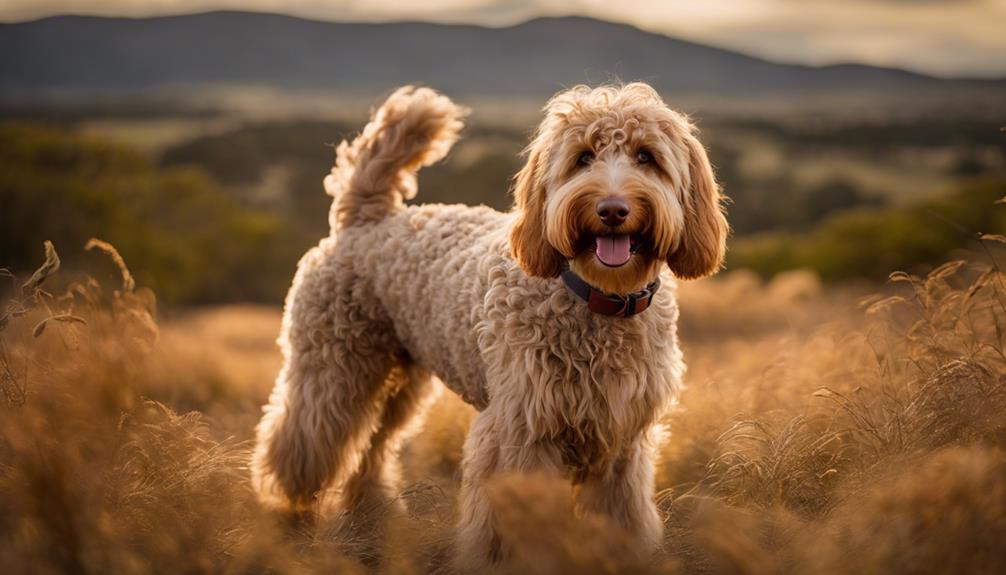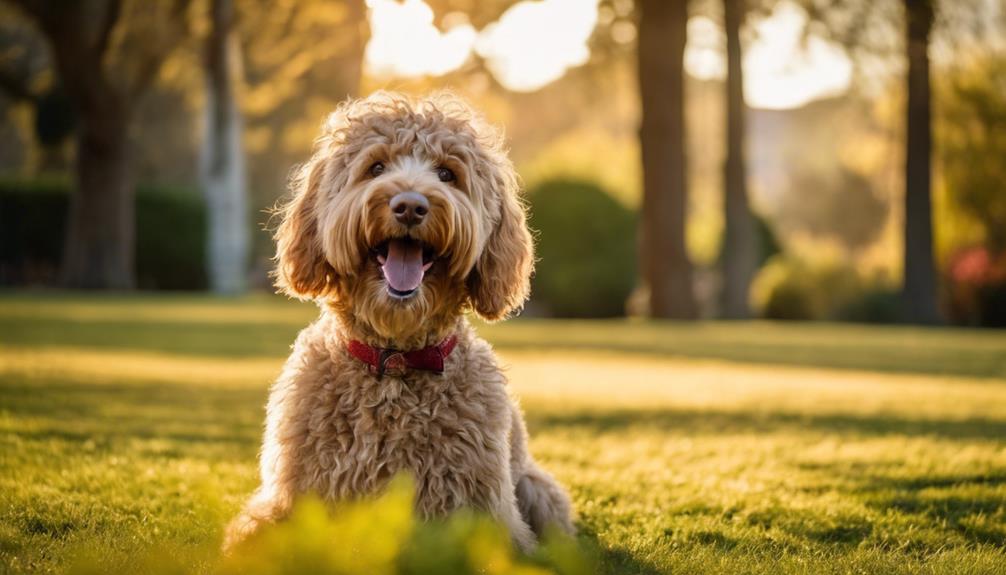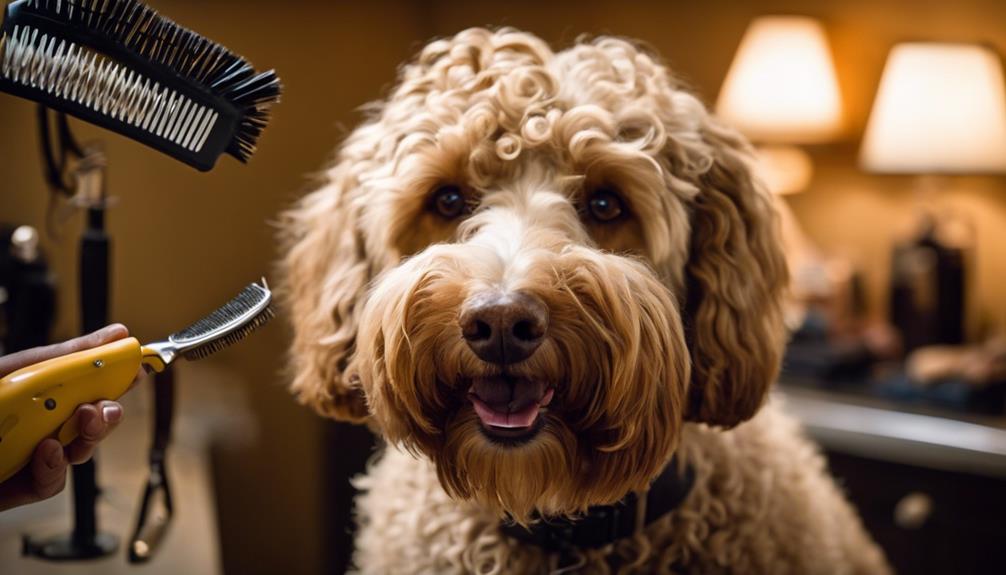Quintessential Traits of Australian Labradoodle
Originating from Australia in the 1980s, the Australian Labradoodle is a unique mix of Labrador Retrievers, Poodles, and Cocker Spaniels. This breed stands out due to its ability to adapt to a variety of living situations. It comes in three sizes: Micro Mini, Mini/Medium, and Standard. Additionally, it has three types of coats: fleece, wool, and hair. This makes it a versatile option for different homes and lifestyles.
Known for its friendly, gentle, and loyal nature, the Australian Labradoodle makes an excellent pet for families. It gets along well with children and other animals. However, it does require consistent grooming and attention to its health. Conditions such as hip dysplasia and Progressive Retinal Atrophy (PRA) are potential concerns. By staying informed about their health needs, owners can ensure these dogs lead happy and healthy lives.
Key Takeaways
- Australian Labradoodles mix Labrador, Poodle, and Cocker Spaniel.
- They’re friendly, adaptable, perfect for family life.
- Exercise, grooming, and diet keep them healthy and happy.
Quick Facts
The Australian Labradoodle hails from Australia and is a mixed breed known for its versatility in size, making it a great match for different types of homes, from apartments to spacious houses. Males typically stand 21-26 inches tall, while females reach 18-22 inches. Their weight also varies, with males ranging from 50-75 pounds and females from 40-65 pounds. This size range means they can fit well into various living situations.
One of the breed’s standout features is its coat, which can be curly, wavy, or straight. This, along with a wide range of colors, makes the Australian Labradoodle highly sought after. The breed’s coat variations and color diversity are the results of its mixed breed heritage, incorporating genetics from several breeds to create a distinctive look and feel. This not only adds to their visual appeal but also makes them adaptable to different weather conditions and lifestyles, ensuring they are excellent companions for many people.
Overview

To fully appreciate the Australian Labradoodle, it’s essential to delve into their origins and how they’ve been developed over time. These dogs first came about in Australia during the 1980s, born from a thoughtful mix of Labrador Retrievers, Poodles, and Cocker Spaniels. The goal was to breed a dog that was not only friendly and intelligent but also perfect for service and therapy roles. Breeders were keen on nurturing qualities like a calm demeanor and the ability to adapt, traits that now define the Australian Labradoodle.
In their development, practicalities such as size and coat type were also considered. This has resulted in Micro Mini, Mini/Medium, and Standard sizes to suit different living situations. The breed also boasts three types of coats: fleece, wool, and hair. Each requires a certain care routine, showcasing the breeders’ dedication to producing dogs that fit well into various lifestyles, whether it’s in a bustling family home or assisting as therapy dogs.
Low-shedding Coats
Australian Labradoodles are a great choice for people with allergies, thanks to their low-shedding coats. This breed comes with three different coat types: fleece, wool, and hair, each designed to minimize allergic reactions and keep homes cleaner by reducing pet hair.
| Coat Type | Texture | Maintenance Required |
|---|---|---|
| Fleece | Soft, Wavy | Moderate |
| Wool | Curly, Dense | High |
| Hair | Straight/Wavy | Low to Moderate |
The table shows the main coat types of Australian Labradoodles, their texture, and how much work they need to stay in good shape. Despite their low shedding, these dogs still need regular grooming to avoid mats and keep their coats healthy. This includes brushing, detangling, and sometimes, professional grooming, depending on the coat.
Choosing an Australian Labradoodle can make life easier for allergy sufferers and those looking to avoid the mess of dog hair in their homes. Their unique coats not only support a cleaner living space but also make these dogs an inclusive option for various households.
Breed Origins

The Australian Labradoodle was originally bred in the 1980s in Australia, combining the best traits of the Labrador Retriever, Poodle, and Cocker Spaniel. This breeding effort aimed to create a dog that excelled in service and therapy roles, focusing on a friendly temperament and a coat that was easy to manage. The breed’s development was carefully planned to ensure dogs were healthy, had great temperaments, and coats suitable for people needing assistance.
The breed has become known for its low-shedding coat, which is a huge plus for families wanting to avoid too much hair around the house. This special feature, along with their friendly nature, has made Australian Labradoodles increasingly popular worldwide. They are celebrated for being versatile, having coats that don’t cause allergies, and being marketed effectively for their friendly personalities.
An interesting fact about Australian Labradoodles is that they do not have Australian Shepherd dogs in their ancestry. This common misconception is cleared up when looking at the breed’s specific origins and the goals breeders had in mind.
Early Breed Development
In the 1980s, Australian breeders set out to create the Australian Labradoodle by mixing Labrador Retrievers, Poodles, and Cocker Spaniels. They aimed to produce a dog that excelled in service and therapy roles. This effort was more than just mixing breeds; it was a strategic move to blend the best qualities of each breed into one. Qualities like smarts, non-shedding coats, and a friendly nature were all targeted.
The process to create the Australian Labradoodle was meticulous. Breeders carefully selected dogs to ensure the new breed had consistent looks, coat types, and personalities. This was different from the American Labradoodle. The goal was to have a dependable pet that families could rely on, showing the importance of thoughtful breeding beyond just the dog’s appearance.
Unique Traits Emergence
In the 1980s, breeders in Australia embarked on a careful breeding program to create the Australian Labradoodle. This dog breed stands out for its intelligence, easy-to-care-for coats that don’t shed, and friendly nature. The breeders aimed to mix Labrador Retrievers, Poodles, and Cocker Spaniels to produce a dog ideal for service and therapy work. The goal was to have dogs that were not only good at their jobs but also had the right looks, coat types, and temperaments.
The addition of both English and American Cocker Spaniels to the mix was a strategic move. It not only broadened the gene pool but also cemented the breed’s special traits. This intentional crossbreeding effort has resulted in a breed that’s truly one of a kind, with DNA tests confirming its unique heritage. The Australian Labradoodle’s creation demonstrates the power of thoughtful breeding in developing a dog breed that’s well-suited for helping people.
Global Popularity Rise
Since the 1980s, the Australian Labradoodle has become a beloved breed worldwide. It began in Australia, where Labrador Retrievers, Poodles, and Cocker Spaniels were carefully mixed to create it. This breed was first made for service and therapy jobs, but people quickly fell in love with its friendly and outgoing personality, making it a great choice for families.
The popularity of the Australian Labradoodle keeps growing because they are well-built, have coats that don’t shed much, and are generally calm. Breeders and groups like the ALAA are crucial in keeping track of the breed’s lineage and promoting good breeding habits. This helps keep the Australian Labradoodle’s special qualities intact, making them even more desirable all over the world.
Medium to Large Breed

The Australian Labradoodle stands out as a versatile breed that blends the best traits of medium and large dogs. Owners should carefully evaluate its characteristics to ensure it matches their lifestyle. Size, energy levels, personality, health risks, and grooming demands are key factors to consider, impacting how well it adapts to various homes and the care it needs.
For size, males usually measure between 21-26 inches in height and weigh about 50-75 pounds. Females are a bit smaller, standing 18-22 inches tall and weighing 40-65 pounds. This size range makes them manageable yet sturdy companions.
Australian Labradoodles have a lot of energy and thrive on activity. They need daily exercise and brain games to stay healthy and happy. This breed’s friendly and smart nature makes it a great family pet, always eager to engage and socialize.
When it comes to health, being proactive about conditions like hip dysplasia and Progressive Retinal Atrophy (PRA) is crucial. Regular vet check-ups and a healthy lifestyle can help manage these risks.
Ideal Size Range
When it comes to understanding the ideal size of Australian Labradoodles, especially those classified as medium to large breeds, it’s all about their height and weight. Standard Australian Labradoodles are usually between 22-24 inches tall and weigh between 45-77 pounds. This size puts them firmly in the medium to large dog category.
On the other hand, miniature Australian Labradoodles are a bit smaller, with heights ranging from 17-22 inches and weights from 30-50 pounds, which means they sometimes fall into the standard size range.
There’s also a noticeable difference between males and females, with males often being taller and heavier than their female counterparts in both the standard and miniature versions. This difference highlights the need to consider both the dog’s gender and their category when figuring out the perfect size for an Australian Labradoodle.
Exercise Requirements
To maintain optimal health and happiness, Australian Labradoodles, particularly those that are medium to large in size, should engage in exercise for about 30 to 50 minutes daily. This regimen should combine physical activities with tasks that challenge their minds. Given their low to moderate energy levels, such a routine is crucial to prevent health issues that arise from inactivity. Studies show that exercises which engage both the body and the brain significantly boost their overall health. While some dogs may enjoy long walks or jogs, what’s most important is keeping up with this routine regularly to ensure the health of an Australian Labradoodle. It’s also key to customize their exercise plan based on their individual likes and energy levels, highlighting the need for a tailored approach to meet their exercise requirements effectively.
Regular exercise is not just good for their physical health but also keeps them mentally sharp. For Australian Labradoodles, mixing in activities like fetching, agility training, or puzzle toys can keep them engaged and happy. This mix helps to keep every day interesting for them and prevents boredom. Matching the exercise to what the dog enjoys and can handle physically ensures they’re getting the most out of their daily activities. This personalized approach to their exercise regime is essential for their well-being.
Temperament Traits
Australian Labradoodles are known for their friendly nature and adaptability, making them great companions for families. They are easy to train due to their intelligence and eagerness to please. Breeders focus on preserving these qualities, ensuring these dogs continue to be gentle, non-aggressive, and loyal. Their intelligence and playful spirit are key reasons they are sought after as pets.
These dogs get along well with kids and other pets, making them sociable and perfect for various roles, including guide dogs. However, they do best with a consistent leader who can guide them through their training. This approach helps maintain their well-being and keeps their training on track.
Health Considerations
Australian Labradoodles face a few health challenges such as hip dysplasia, progressive retinal atrophy, and patella disorders. These issues can greatly affect their quality of life, which makes careful and proactive care essential. Good breeding practices are key to minimizing these health risks. This includes conducting health screenings and genetic tests to reduce the risk of inheritable conditions like Von Willebrand’s disease and elbow dysplasia.
Regular vet check-ups are crucial for catching and treating any health issues early on. This proactive approach can help extend an Australian Labradoodle’s life. A healthy diet, regular exercise, and proper care can also prevent some genetic conditions. Following these steps ensures these dogs live a full and healthy life, meeting the breed’s standards for wellness.
Grooming Needs
Caring for an Australian Labradoodle’s coat requires a hands-on and consistent approach due to its unique texture, which varies from curly and wavy to straight. This breed’s coat care is a moderate to significant responsibility, calling for a disciplined routine. Regular grooming is crucial to avoid the mats that often form in thicker coats. Brushing the coat a few times every week helps manage shedding and keeps it free from knots.
It’s also advised to visit a professional groomer every 6 to 8 weeks. They can trim and shape the coat properly, making sure it meets the breed’s grooming standards. Bathing should be done as needed, using a dog-specific shampoo to keep the coat clean and healthy. This approach not only maintains the dog’s appearance but also contributes to its overall well-being.
Affectionate Nature

The Australian Labradoodle is known for its warm and loving nature, making it a perfect fit for families and therapeutic settings. This dog breed’s ability to form deep connections with people is a testament to its friendly personality. Understanding how Australian Labradoodles show love and bond with humans is key to appreciating their role as companion animals.
Showing Love: We look into the ways Australian Labradoodles express their affection towards people. This includes physical gestures and behaviors that reflect their closeness to their human friends.
Family Bonds: We focus on how these dogs create lasting relationships with their human families. The strength of these bonds is crucial for both the dog’s and the family’s well-being.
Love Signals: We identify the specific actions by Australian Labradoodles that indicate their love. Recognizing these signs helps in understanding their emotional state.
Benefits of Social Interaction: We examine the positive effects on humans who interact with these loving dogs. The emotional and psychological benefits are significant for both the dog and its human companions.
In each of these areas, the Australian Labradoodle’s affectionate behavior is central. By exploring how they express love, bond with families, show signs of affection, and benefit human companions, we gain a deeper understanding of their importance in human lives.
Expressing Affection
Australian Labradoodles are known for their deep affection towards their owners, showing love through cuddles, kisses, and playful activities. This behavior isn’t just a trait; it’s crucial for their emotional growth. These dogs love being around people and can even pick up on how their owners are feeling, making them great empathetic friends. Their ability to connect on an emotional level also makes them perfect as therapy and emotional support dogs. They offer comfort and friendship to those who need it, showcasing the healing power of their affection.
In a world where mental health awareness is on the rise, the role of Australian Labradoodles as emotional support animals becomes even more significant. They not only provide companionship but also a form of therapy that doesn’t come from a bottle or a therapy session. It’s amazing how these dogs can sense and adapt to the emotional states of their humans, offering a paw or a nuzzle at just the right moment. Their actions serve as a reminder of the importance of caring relationships in both human and animal lives.
Bonding With Families
Australian Labradoodles naturally connect deeply with their families, making them perfect companions. Their genuine affection goes beyond being just friendly; it’s a core part of who they are, allowing them to become integral members of the family. They love being around people and are always ready to join in on any family fun. This makes them the ideal choice for a family pet.
Australian Labradoodles have a social and friendly nature, along with a keen sense of human emotions. This makes them great at understanding and fitting into the emotional rhythm of a household. Such a close and understanding relationship improves life for everyone in the family, showcasing how in tune these dogs are with their human friends.
Signs of Love
Australian Labradoodles are known for their deep affection towards their families, showing love through physical touch and understanding emotions.
These dogs are smart enough to pick up on how their owners are feeling and respond in ways that offer comfort and support. They love to cuddle, stay close to their human friends, and seek attention by wagging their tails, giving kisses, and leaning on their loved ones.
This behavior shows how loyal and devoted they are, making them perfect companions. Australian Labradoodles truly shine in giving and receiving love, making every moment with them special.
Social Interaction Benefits
Australian Labradoodles are known for their loving nature and ability to connect deeply with their owners, contributing positively to one’s emotional health. They are especially good at picking up on human feelings, making them excellent companions for those in need of emotional support. With their cheerful and playful attitude, these dogs are great at encouraging social interaction, which is key to maintaining mental health and reducing feelings of isolation.
Their calm and friendly behavior makes them perfect for anyone looking for a therapeutic friend. The impact that Australian Labradoodles have on fostering human connections and improving emotional well-being is substantial. They not only bring joy and companionship but also play a critical role in enhancing the quality of life for their human friends.
Building Strong Connections
Australian Labradoodles are naturally affectionate dogs that love being close to people. They thrive on interaction and enjoy being part of the family, often showing their love by cuddling and seeking attention. This makes them excellent therapy and emotional support dogs, providing real comfort and support to those who need it.
These dogs are also incredibly empathetic, tuning into their owners’ feelings with surprising accuracy. Their gentle and calm nature makes them perfect for families, ensuring they’re not just pets but cherished companions. This ability to connect deeply with humans is at the heart of what makes Australian Labradoodles such beloved family members.
Lifespan Concerns

The lifespan of an Australian Labradoodle typically ranges from 12 to 15 years. To ensure they live a full and healthy life, it’s crucial to consider several factors such as diet, exercise, and their genetic background. Addressing these factors can significantly impact their overall health and longevity.
- Taking preventative steps and being proactive about health can significantly increase their lifespan. Regular vet check-ups and keeping up with vaccinations are essential.
- Australian Labradoodles may face certain health conditions more frequently than other breeds. Being aware of these and knowing how to manage them is vital.
- A balanced diet and regular exercise are fundamental in keeping them healthy for years to come. This includes high-quality dog food and daily physical activity.
- Genetics play a role in their health outcomes. When choosing a puppy, it’s important to consider their lineage and any hereditary conditions.
Understanding these aspects and taking appropriate actions will help in maximizing the health and happiness of Australian Labradoodles.
Lifespan Extending Tips
For Australian Labradoodles to live long and healthy lives, a comprehensive approach that includes proper nutrition, consistent exercise, and regular healthcare is essential. Tailoring their diet to meet the unique needs of their breed will help keep them in top shape.
Physical activity is not just good for their bodies, but it also keeps their minds sharp, which is crucial for their overall well-being and longevity.
Regular visits to the vet for check-ups and preventive measures are key to catching any health issues early. Taking steps to ensure genetic health through careful breeding can also reduce the risk of inherited conditions, leading to a longer life for these dogs.
Together, these efforts create a strong foundation for Australian Labradoodles to not only live longer but enjoy a better quality of life.
Common Health Issues
For Australian Labradoodles, maintaining their health involves more than just a balanced diet, regular exercise, and routine vet visits. It’s crucial to be aware of certain health issues that can impact their life quality and duration. Conditions such as hip dysplasia, progressive retinal atrophy, Von Willebrand’s disease, along with elbow and patella disorders, can significantly affect their daily activities. These issues, if not managed well, have the potential to reduce their lifespan.
Regular vet check-ups play a key role in catching these health problems early. This proactive approach allows for better management of the conditions, helping to ensure a longer and happier life for your pet.
On the breeding side, choosing dogs with good health records for breeding is essential. This practice helps lower the chances of passing on genetic diseases to puppies. In turn, this cautious approach to breeding contributes to the improvement of the breed’s health over time.
Diet and Exercise Impact
Knowing how diet and exercise affect the health and lifespan of Australian Labradoodles is key to their well-being. Research shows that a good mix of healthy food and regular activity greatly improves how long Australian Labradoodles live. It’s important to pay attention to what they eat, how much they move, their genetic makeup, and keeping them safe from injuries.
Interestingly, the size of the Labradoodle can also play a role in how long they live, with smaller ones often living longer.
Taking good care of these dogs, through proper nutrition and exercise, can help them live longer, typically between 12 to 15 years. So, having a smart plan for their diet and physical activity is crucial for a healthy life.
Grooming Needs

Grooming Australian Labradoodles involves understanding their unique needs based on coat type and how much they shed. To ensure these dogs look and feel their best, here are some key aspects to keep in mind:
- Different Coat Types: Australian Labradoodles come with fleece, wool, or hair coats, each requiring specific grooming techniques.
- Brushing is Crucial: To avoid mats, especially in tangle-prone zones, brushing them daily is essential.
- Shedding Insights: Knowing how much an Australian Labradoodle sheds helps in determining the grooming effort needed.
- Expert Grooming Advice: Regular visits to a professional groomer can complement your home care routine, keeping your dog’s coat in prime condition.
Caring for an Australian Labradoodle’s coat requires a mix of daily upkeep and professional grooming based on their coat type and shedding. Keeping their coat free of mats through daily brushing, especially in areas that tend to tangle, is crucial. Understanding your dog’s shedding patterns can guide the intensity of grooming they need. Additionally, scheduling regular sessions with a professional groomer can support your maintenance efforts, ensuring your dog not only looks great but also remains healthy.
Coat Type Varieties
Australian Labradoodles are known for their three coat types: fleece, wool, and hair. Each type needs a different grooming approach to keep them looking and feeling good. The fleece coat is either wavy or curly and soft to touch. It’s essential to brush it often to prevent mats and keep it shiny. On the other hand, the wool coat is very curly, similar to cotton, and also needs careful grooming to avoid tangles and maintain its unique look.
The hair coat might be straight or have some waves. This coat type benefits from regular brushing and some trimming here and there to reduce shedding and keep the dog looking neat. Proper grooming is key for all Australian Labradoodle coats to stay healthy and attractive. This means knowing how to care for each coat type, using the right tools, and sticking to a grooming schedule.
Daily Brushing Essentials
Keeping an Australian Labradoodle’s coat in top condition requires daily brushing. This routine helps spread natural oils throughout their coat, promoting health and preventing tangles. For their curly or wavy fur, using the right tools, like a slicker brush or a specific comb, is essential. These tools help remove loose hair and prevent mats, keeping the coat clean.
Regular grooming is not just about looking good; it’s also a chance to check for skin problems or pests like fleas and ticks. Starting these grooming habits early is crucial. It makes sure the dog’s coat stays healthy and helps them get used to grooming, making it a stress-free experience for them.
Shedding Levels Explained
Understanding the shedding levels of Australian Labradoodles is crucial because their minimal shedding places them in the hypoallergenic category. This means they’re less likely to trigger allergies, thanks to their unique coat. Since they shed very little, the chance of dander and hair spreading around the house decreases. This is great news for allergy sufferers.
However, their special coat requires regular care to avoid issues like matting and tangling. Not taking care of their coat can lead to uncomfortable tangles for your pet. To prevent this, it’s recommended to brush their coat 2-3 times a week. Regular grooming helps remove any loose hair and keeps their coat in good condition, ensuring they remain a great option for people with allergies.
Professional Grooming Tips
Taking care of an Australian Labradoodle’s coat is crucial for their health and looks. This involves a mix of services like brushing, bathing, and cutting their nails. Australian Labradoodles have coats that don’t shed much but need regular attention to prevent tangles and keep them looking good. It’s recommended to have grooming sessions every 6-8 weeks. This helps keep their coat clean, healthy, and free of mats.
Professional groomers are key in getting the right look for your Labradoodle. They know how to clip, shape, and style the coat perfectly. But grooming isn’t just about making your dog look good. It’s also important for their skin health and overall happiness. Keeping up with grooming is essential for the well-being of your Australian Labradoodle.
Bathing Frequency Guide
Finding the ideal bathing schedule for your Australian Labradoodle depends on their level of activity, the type of coat they have, and their specific grooming requirements. It’s generally recommended to give them a bath every 4-6 weeks to keep their coat healthy without stripping away essential oils that protect their skin. However, if your Labradoodle is more active or has a unique coat type, you might need to adjust this frequency. Washing them too often can harm their coat.
To avoid over-bathing, incorporating regular brushing into their care routine can help maintain their coat’s health, reducing the need for frequent baths. It’s a good idea to consult with a professional groomer or a veterinarian to figure out the best bathing routine for your Labradoodle. This ensures their coat stays clean and healthy without causing any skin issues.
Dietary Requirements

When thinking about the dietary needs of Australian Labradoodles, it’s critical to focus on what keeps them healthy and active. They thrive on a diet that balances proteins, fats, and carbs, tailored with specific vitamins and minerals. This ensures they have the energy they need and maintains the luster of their coats.
Allergies in Australian Labradoodles can be a concern. It’s vital to identify what they can and cannot eat to avoid any adverse reactions. Opting for hypoallergenic food when necessary can make a big difference in their well-being.
Discussing feeding schedules, it’s best to adjust these according to the dog’s age, how active they are, and their growth needs. This approach helps in keeping them at an optimal weight and supports their overall health.
The link between what Australian Labradoodles eat and their health cannot be overstated. Poor diet choices might lead to issues like obesity, digestive troubles, and lack of essential nutrients. Offering them the right food not only keeps them healthy but can prevent these common problems.
In essence, understanding and meeting the dietary requirements of Australian Labradoodles is key to their happiness and longevity. A balanced diet, attention to allergies, correct feeding schedules, and making informed food choices can significantly impact their quality of life.
Optimal Nutrition Needs
To ensure their well-being and match their energetic lifestyle, Australian Labradoodles need a nutritious diet. This diet should mainly include high-quality proteins, fats, vitamins, and minerals. For muscle development and general health, lean meats, fish, and eggs are great protein sources. It’s also vital to incorporate healthy fats, like those from fish oil or flaxseed oil, to keep their coat shiny and support brain health.
Avoiding foods filled with unnecessary fillers, artificial additives, or preservatives is crucial, as they can harm the dog’s health. Consulting a veterinarian or a dog nutrition expert can help tailor a diet plan that specifically suits an Australian Labradoodle’s needs, ensuring they get the right nutrition.
Common Allergies Explored
Many Australian Labradoodles suffer from allergies to foods like grains, soy, dairy, and additives, which can cause symptoms such as itching, skin irritation, digestive issues, and ear infections.
Managing their diet carefully is crucial to help these dogs. A diet with few ingredients, known as a hypoallergenic diet, often helps reduce allergic reactions by avoiding common allergens.
It’s important to work with a vet to identify food allergies and create a diet that avoids these triggers. By monitoring what the Australian Labradoodle eats and steering clear of known allergens, their health can greatly improve.
Feeding Schedules Simplified
Knowing what and how to feed Australian Labradoodles is crucial for their health and happiness. It’s key to choose high-quality dog food that fits their active lifestyle and size, whether they’re a lively puppy or a more laid-back adult. Puppies, with their fast growth and high energy, do best with 3-4 meals a day. Adults, on the other hand, generally need just 1-2 meals daily.
Talking to a vet can help tailor a feeding plan that suits your Labradoodle’s specific needs, taking into account their age, weight, and any health issues. It’s important to steer clear of foods that are harmful to dogs and to keep an eye on your pet’s weight to make sure they’re not over or under-eating. Making sure they always have access to fresh water is also vital for their overall well-being.
Frequently Asked Questions
What Is Special About an Australian Labradoodle?
- Hypoallergenic coat suits allergy sufferers.
- Friendly nature ideal for various settings.
- Unique genetics make it a perfect pet.
What Is Difference Between Australian Labradoodle and Labradoodle?
- Australian Labradoodles mix Poodle, Cocker Spaniel, Labrador.
- Labradoodles mainly Poodle and Labrador blend.
- Breed aims differ between the two.
How Big Does an Australian Labradoodle Get?
- Australian Labradoodles come in sizes from Micro Mini to Standard.
- Weight ranges from 10lbs to over 50lbs.
- Size choice affects lifestyle compatibility.
Are Australian Labradoodles Worth the Money?
- Australian Labradoodles are valued for predictable traits.
- Training them is simpler than many other breeds.
- Their health and temperament justify the expense.

